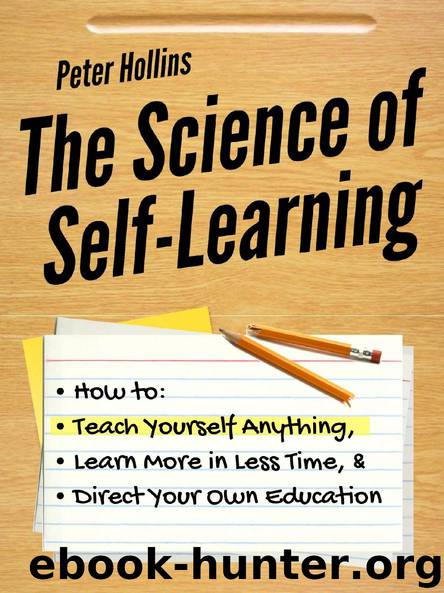The Science of Self-Learning by Peter Hollins

Author:Peter Hollins
Language: eng
Format: epub
Publisher: PublishDrive
Published: 2019-03-12T16:00:00+00:00
Strategically Skim
The next step in reading faster is to understand how to strategically skim your material—after stopping subvocalizations and training your eyes. For most of us, skimming has a negative connotation. It’s when we are rushed for time and can only look at the first sentence of each paragraph—or whatever method you decide makes sense. This is not the same type of skimming.
Frankly, not all information is created equally, and this can be true even within sentences and paragraphs. There are some things that are destined to waste our time in reading, so we should learn exactly what is okay to skip, what to focus on, and how to manage all of that. Skimming information in our context is about saving time and being able to see through what’s in front of you.
Here, we are skimming in a way that lets you retain just as much, just by cutting the fat. Traditional skimming would be skipping about 75% of the content—here, we are only skipping 25% of the content. How are we doing that? There are three interrelated methods.
First, start and stop reading three words from the margin of the pages.
By default, we always start reading the first word on the left of the page and go all the way to the last word on the right. We’ve been taught to be thorough and leave no stone unturned. But here’s the trick: you can start on the third word from the left and stop three words from the end, and your peripheral vision just might pick up the first two and last two words automatically.
In a line of 10 words, this allows you to “read” only six words and save 40% of the effort and time. This obviously adds up quite quickly. As with all these techniques, stop the course and try it for a second. Does it feel odd? Does it feel like you are skipping important information? Just try it out and you’ll find that you aren’t missing anything for comprehension—your brain will fill it in, and you’ll be able to figure it out through the context of the sentence.
Second, skip meaningless words.
To be clear, skipping small words isn’t quite the same thing as skimming what you’re reading. When you skim, you’re not retaining the words or ideas that you’re consuming. You may have a general sense of the work, but the fine details will likely be lost.
Learning how to read faster is all about eliminating the small, unnecessary words that fill up a page. Not every word is created equal. There are plenty of small, obscure little words that don’t help you, and trying to force yourself to read them can only hurt. These words certainly have their place, of course, and we need them to construct sentences and ideas! But when we’re trying to read quickly, we can often skip these words with no ill-effects: “if,” “is,” “to,” “the,” “and,” “was.”
The best part of skipping the small words is that they do not contribute anything useful,
Download
This site does not store any files on its server. We only index and link to content provided by other sites. Please contact the content providers to delete copyright contents if any and email us, we'll remove relevant links or contents immediately.
| Administration | Adult & Continuing Education |
| Business School Guides | College Guides |
| Financial Aid | Graduate School Guides |
| Law School Guides | Medical School Guides |
| Test Preparation | Vocational |
Navigation and Map Reading by K Andrew(4859)
Spare by Prince Harry The Duke of Sussex(4747)
Tuesdays with Morrie by Mitch Albom(4355)
Cracking the GRE Premium Edition with 6 Practice Tests, 2015 (Graduate School Test Preparation) by Princeton Review(3999)
What It Really Takes to Get Into Ivy League and Other Highly Selective Colleges by Hughes Chuck(3517)
Never by Ken Follett(3489)
Machine Learning at Scale with H2O by Gregory Keys | David Whiting(3440)
Goodbye Paradise(3413)
Harry Potter and the Prisoner of Azkaban (Book 3) by J. K. Rowling(3082)
Pledged by Alexandra Robbins(3028)
Kick Ass in College: Highest Rated "How to Study in College" Book | 77 Ninja Study Skills Tips and Career Strategies | Motivational for College Students: A Guerrilla Guide to College Success by Fox Gunnar(2976)
Fairy Tale by Stephen King(2855)
A Dictionary of Sociology by Unknown(2828)
Sapiens and Homo Deus by Yuval Noah Harari(2815)
The Social Psychology of Inequality by Unknown(2723)
Graduate Admissions Essays, Fourth Edition: Write Your Way into the Graduate School of Your Choice (Graduate Admissions Essays: Write Your Way Into the) by Asher Donald(2707)
Reminders of Him: A Novel by Colleen Hoover(2679)
Get into Any College by Tanabe Gen Tanabe Kelly(2612)
Zero to Make by David Lang(2600)
